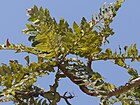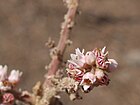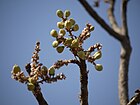Note: This is a project under development. The articles on this wiki are just being initiated and broadly incomplete. You can Help creating new pages.
Boswellia serrata - Shallaki
Boswellia serrata is a plant that produces Indian frankincense, Salai, referred to in Sanskrit as shallaki and in Latin as Olibanum Indicum. the plant is native to much of India and the Punjab region that extends into Pakistan.
Uses
Arthritis, Joint pain, Chronic inflammatory diseases, Bronchial asthma, Ulcerative colitis, Crohn's disease, Chronic lung diseases, Diarrhoea, Dysentery, Pulmonary diseases.
Parts Used
Chemical Composition
Common names
| Language | Common name |
|---|---|
| Kannada | Madi |
| Hindi | Salai |
| Malayalam | |
| Tamil | |
| Telugu | |
| Marathi | |
| Gujarathi | |
| Punjabi | |
| Kashmiri | |
| Sanskrit | |
| English | Boswellia serrata |
Properties
Reference: Dravya - Substance, Rasa - Taste, Guna - Qualities, Veerya - Potency, Vipaka - Post-digesion effect, Karma - Pharmacological activity, Prabhava - Therepeutics.
Dravya
Rasa
Guna
Veerya
Vipaka
Karma
Prabhava
Habit
Identification
Leaf
| Kind | Shape | Feature |
|---|---|---|
| Pinnate | Alternate | Apically clustered, estipulate; rachis 11-44 cm, slender, pubescent, swollen at base; leaflets 15-31, sessile or subsessile, opposite or subopposite; lamina 0.8-9.5 x 0.5-3.5 cm, elliptic-oblong, oblong-lanceolate, oblong-ovate, base oblique, acute, apex obtuse, margin entire or crenate, chartaceous, glabrous; lateral nerves 8-14 pairs, pinnate, faint, intercostae reticulate, faint. |
Flower
| Type | Size | Color and composition | Stamen | More information |
|---|---|---|---|---|
| Bisexual | Axillary sub-terminal racemes | white | 10 | calyx pubescent, tube broadly campanulate, short; lobes 5-7, persistent; petals 5-7, 7 x 2.5-4 mm, white, ovate-oblong, shortly clawed, inflexed at apex pubescent out side except margin; disc annular, crenate, free from calyx; stamens 10, free, filaments alternately longer and shorter connective produced beyond the anther lobe; ovary sessile, superior, ovoid, 3-celled, ovules 2 in each cell; style to 3 mm, grooved; stigma 3-lobed. |
Fruit
| Type | Size | Mass | Appearance | Seeds | More information |
|---|---|---|---|---|---|
Other features
List of Ayurvedic medicine in which the herb is used
Where to get the saplings
Mode of Propagation
How to plant/cultivate
Seeds are sown immediately after collection. The rate of germination is about 25-30 %. [3]
Commonly seen growing in areas
Photo Gallery
References
External Links
- Ayurvedic Herbs known to be helpful to treat Arthritis
- Ayurvedic Herbs known to be helpful to treat Joint pain
- Ayurvedic Herbs known to be helpful to treat Chronic inflammatory diseases
- Ayurvedic Herbs known to be helpful to treat Bronchial asthma
- Ayurvedic Herbs known to be helpful to treat Ulcerative colitis
- Ayurvedic Herbs known to be helpful to treat Crohn's disease
- Ayurvedic Herbs known to be helpful to treat Chronic lung diseases
- Ayurvedic Herbs known to be helpful to treat Diarrhoea
- Ayurvedic Herbs known to be helpful to treat Dysentery
- Ayurvedic Herbs known to be helpful to treat Pulmonary diseases
- Herbs with Flowers used in medicine
- Herbs with Seeds used in medicine
- Herbs with common name in Kannada
- Herbs with common name in Hindi
- Herbs with common name in English
- Habit - Deciduous tree
- Index of Plants which can be propagated by Seeds
- Herbs that are commonly seen in the region of Dry hill areas
- Herbs
- Ayurvedic herbs that don't have seed photos
- Burseraceae




